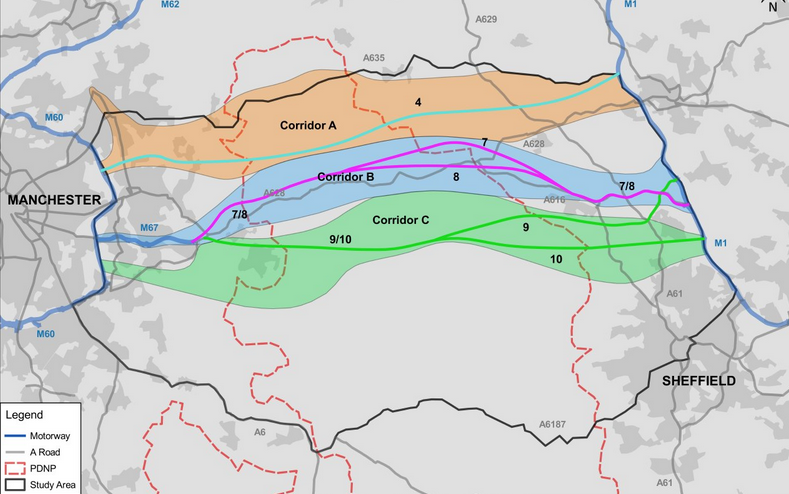My new book published on 1 September is one in a series of short books on policy and economics topics described as ‘essays on big ideas by leading writers’. My contribution is a critique of the inconsistencies of transport policy in recent decades, which I attribute to the shortcomings of conventional transport economic appraisal in identifying the benefits that arise from investment. This book, Travel Fast or Smart?, is available both in print and as an ebook from Amazon Books.
Three studies of prospective road investments in the North of England have been published recently. These illustrate some of the questions that arise when the aim is to boost economic growth by increasing road connectivity between cities.
M60: Manchester North-West Quadrant
The NW section of the M60 orbital motorway within Manchester is one of the busiest roads in the country, on account of the mix of local and strategic traffic. Traffic congestion, local air quality and noise are considered to inhibit economic growth.
A number of road schemes are proposed to improve matters: new outer orbital roads to divert strategic traffic from the inner orbital M60, plus improvements to enhance capacity of the M60 itself. The benefits have been assessed, according to standard practice, on the basis of the value of journey time savings, which typically are quite small – up to 5-12 min for strategic long distance users and up to 3-5 min for local users. The capital costs are estimated at around £14 billion.
A public transport only scheme has also been considered but rejected since it offered no journey time savings for road users.
This study addresses the most northerly major east-west road routes in England, currently underused on account of poor journey time reliability, high collision rates, high proportion of Heavy Goods Vehicles and lack of alternative routes if diversion is needed due to poor weather or road works. Parts of these routes are still single carriageway. Capital costs are estimated at about £5 billion. No quantitative estimation of benefits has yet been made.
This scheme involves a ‘bold concept’ – building a tunnel under the Peak District National Park to improve road connectivity between Manchester and Sheffield, with journey time saving of up to 30 min. Depending on the precise route, the length of tunnel would be 12-20 miles, longer than most road tunnels in Europe, costing £8-12 billion. No quantitative estimation of benefits has yet been made.
Assessment
The total cost of these three schemes is put at up to about £30 billion, which is twice the total investment planned under the current five year Road Investment Strategy. It is very hard to see how the economic benefits could justify such expenditure, not least because the evidence for benefits from improving the connectivity of cities around 50 miles apart in thin (see my discussion of Glasgow and Edinburgh, two well connected cities).
Moreover, standard economic analysis does not distinguish between benefits to commuters and to long distance users. As I have argued, in situations like the urban M60, where car commuters comprise 40% of morning peak traffic, it would be commuters that would take advantage of any increased capacity, leaving long distance users no better off – consistent with the maxim that you can’t build your way out of congestion.
Standard economic appraisal, based on time savings to road users, takes no account of the way transport investment makes land accessible for development and so contributes to economic growth. Such development results from investment in urban public transport, as for example at MediaCity in Greater Manchester. The rejection of public transport investment as a means of mitigating congestion on the M60 reflects this disregard of development in standard appraisal.
The construction costs estimated at this stage are not to be relied upon. Very likely ‘optimism bias’ is at work, underestimating costs and overstating benefits at an early stage, to ensure the project remains under consideration, consistent with a ‘bias to action’ on the part of promoters and their agents when there is an opportunity to spend other peoples money.
On the other hand, the estimates of fairly small time savings are consistent with the outcomes of previous road investments, raising a question about the nature and value of incremental investment in a mature road system that generally provides dual-carriageway or better connectivity to all major cities.
What is entirely missing from these studies of road investment is any consideration of how digital technologies might help meet the needs of users, technologies that can be far more cost-effective that the very expensive civil engineering technologies that have dominated thinking about the road system. This is in marked contrast to the railways where the virtues of the ‘digital railway’ are increasingly recognised.
There is too much wishful thinking about the economic benefits of investment in road infrastructure, particularly in the context of the ‘Northern Powerhouse’, the North of England seen as a region with unrealised economic potential. More rigorous analysis is needed, otherwise outcomes will be disappointing.

